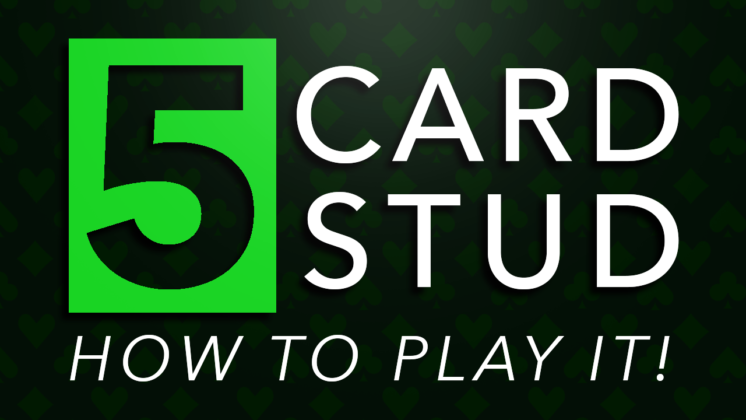5 Card Stud poker is one of the oldest poker games out there seemingly invented during the Civil War, and it has been played ever since.
Over the years, 5 Card Stud evolved into 7 Card Stud, which later gave birth to other poker games like Texas Hold’em. Back in the day, however, poker was mostly played as either 5 Card Draw or 5 Card Stud.
While 7 Card Stud remains a game often spread to this day, especially as part of Mixed Games, 5 Card Stud is a less frequent variation and is one that many players don’t even know how to play.
However, the more poker games you know, the better, so let’s take a look at the basic rules of 5 Card Stud poker and learn how it differs from the more traditional poker games like Texas Hold’em or PLO.
- Basics of 5 Card Stud – Antes, Bring-In, and the Second Street
- Third Street in 5 Card Stud Poker
- Fourth Street in 5 Card Stud Poker
- Fifth Street in 5 Card Stud Poker
- Showdown in 5 Card Stud Poker
- Player Actions in Five Card Stud
- Poker Hand Rankings in Five Card Stud
- Basic Five Card Stud Strategy
- Where to Play Five Card Stud Poker
Basics of 5 Card Stud – Antes, Bring-In, and the Second Street
The game of 5 Card Stud poker is reasonably simple to play, and it involves fewer nuances than the more modern poker variations.
For Texas Hold’em and Pot Limit Omaha players, the first thing to remember is that there are no community cards in 5 Card Stud. Instead, each player receives a total of five hole cards only.
The objective of the game is to make the best five card poker hand, according to standard poker hand rankings, or make all other players fold their cards before showdown.
The game starts with each player at the table posting an ante bet, whose value is a fraction of one big bet. For instance, in a $4/8 Five Card Stud game, an ante bet might be $1, which means every player must put $1 into the pot before the deal begins.
Then, the dealer deals the first two cards to all the players at the table, with one card dealt face down and the other dealt face up for the entire table to see.
Once everyone has their hole cards, the player who is showing the lowest hole card has to post the bring-in, which is a bet designed to drive the action further on top of the antes.

In the same $4/8 game we mentioned earlier, the bring-in would be valued at $2, and the player showing the lowest card would have to post $2 to start the hand. Alternatively, the player could complete the small bet to $4 right away if they like their cards, which is usually not the case.
From here, the action goes around the table, with players given a chance to complete the small bet, and up to three further raises are allowed until second street betting is completed and the game proceeds to third street.
Third Street in 5 Card Stud Poker
Once all second street action is completed, the dealer deals another card to each player face up. This time around, the player showing the highest up card, or the highest pair, gets to act first.
The player can decide to check his option or make a bet, with a small bet still being used as the betting increment. Up to three raises are allowed on top of this initial bet.
For all players who are coming from no-limit or pot-limit poker games, it is important to note that Stud games are always played as limit games, which means the size of your bets and raises is limited by the small and big bet.
For instance, the only bet you can make on the third street in Five Card Draw in a $4/8 game is $4, and players can make subsequent raises to $8, $12, and $16. No other betting or raising options are allowed.
Fourth Street in 5 Card Stud Poker
Once all action is completed on third street, the dealer deals yet another card to each remaining player in the hand, once again face up.
Players who are still active in the hand now hold three cards face up and one card face down, and the player showing the best hand gets to act first.
Note that only pairs and three of a kind count towards the high hand, as any flush or straight options you may have at this point don’t have any hand value yet.
Once again, bets are made in small bet increments, with up to three raises possible on top of the original small bet.
Fifth Street in 5 Card Stud Poker
Finally, once all fourth street betting is done, the dealer deals the final fifth card to each active player, again face up.
The remaining players now have all five of their cards, with the initial card being the only one hidden from other players and the remaining four cards available for everyone to see.
Once again, the player whose shown hand is the strongest gets to act first, with action going around the table clockwise.
This time around, all bets and raises are made in increments of one big bet, which means in our $4/8 game, the bets would be $8, $16, $24, and $32, making this the biggest betting round of them all.
Showdown in 5 Card Stud Poker

According to 5 Card Stud Rules, once all fifth street betting is completed, the dealer will announce a showdown if there is more than one player still involved in the hand.
At this point, players must show their hole cards, with the one who had first action on fifth street going first, and the remaining players around the table showing their hands clockwise.
When players reveal their down cards, the dealer will compare the hands by poker hand rankings and announce the winner.
If two or more players have the exact same hand, the dealer will split the pot. However, note that split pots are quite rare in Five Card Stud poker, as there are no community cards in play.
Player Actions in Five Card Stud
Like other forms of poker, Five Card Stud gives players multiple actions to choose from across all betting streets, starting with second street.
Note that some of the actions are not possible in some situations, while some, like bring-in, are reserved only for the second betting street.
Here is a full list of possible player actions in Five Card Stud poker:
- Bring-In: On the second street, the players with the lowest up card must post a bring-in worth half of a small bet.
- Complete: The player posting the bring-in can choose to complete one small bet if they so choose.
- Check: On betting streets from third to fifth, if there is no active bet, players can choose the pass the option to the next player at the table without making a bet.
- Bet: On betting streets from third to fifth, if there is no active bet, players can choose to make a bet. The small bet is used on earlier betting streets, and the big bet is on fifth street.
- Raise: On all betting streets, when there is an active bet in play, players can choose to raise the bet. Up to three raises can be made on each betting street.
- Fold: At any point when facing a bet or raise, players can choose to fold their cards. Once their cards are folded, the player is no longer active in the hand.
- All-In: While all-in situations are somewhat rare in limit games, if a player puts the last of their chips into the pot, they are considered all-in. After this point, their hand will get to showdown, but they will not be in play for any bets they were not able to cover.
Poker Hand Rankings in Five Card Stud
Five Card Stud is a typical poker game, which means the usual poker hand rankings apply, which Texas Hold’em or Draw Poker players will already be familiar with.
However, if this is your first time learning poker, or you simply want a quick refresher, here is a look at the Five Card Stud poker hand rankings from best to worst:

- Royal Flush: Ac Kc Qc Jc Tc
- Straight Flush: 7h 6h 5h 4h 3h
- Four of a Kind: 5s 5h 5c 5d Js
- Full House: Qd Qc Ts Th Tc
- Flush: Ad 9d 7d 5d 3d
- Straight: Jh Td 9d 8h 7c
- Three of a Kind: 7h 7c 7d Qs 6c
- Two Pair: Kd Kh Js Jd 6c
- One Pair: 8s 8c Kd 7h 4s
- High Card: Qs 9h 7c 5d 2s
Whenever more than one player has a hand of the same ranking at a showdown, the one whose cards are higher in ranking will win.
For example, one pair of Kings will beat one pair of Jacks, while two pair of Aces and Deuces will beat two pair of Kings and Queens.
If two players have the same hand, such as a pair of Aces, the dealer will compare the players’ highest non-paired card, called the kicker. The player with the higher kicker will win the pot.
If two players have a flush at showdown, the one with the highest card in their flush will win the hand, regardless of the suit of the given flush. If both players have the exact same flush, they will split the pot.
Basic Five Card Stud Strategy
Now that you know the basic Five Card Stud rules, you are ready to play your first game. However, before you do that, you may also want to learn at least the very basics of Five Card Stud strategy.
The truth is Five Card Stud is a significantly simpler game than the likes of No Limit Hold’em, as both the betting options and the potential hands each player can have at any given time are limited.
However, this is why mistakes cost so much in Five Card Stud, as any mistake made is not as easily compensated for as in no limit games.
To begin with, your strategy will be to steal the antes and the bring-in as often as possible. Your ability to do so will depend heavily on how aggressively other players at the table defend the dead money.
As a hand of Five Card Stud starts, your first job will be to see and memorize all the up cards, which can give you a significant advantage moving forward.
Once you know all the cards that have been folded, you will look at your down card and decide if your hand is good enough to proceed.
Note that it is not very easy to have a pair to start with in Five Card Stud, but you will not want to enter pots from early positions without holding a pair or at least two suited high cards.
From later positions, you may try to go for a raise if your up card is a high one, such as Ace or King, as this allows you to represent a big pocket pair and steal the antes often.
Stud games are really all about stealing the antes and not chasing your draws against the odds, so remember to be willing to fold your cards once it is clear that your opponents have a hand and aren’t going anywhere.
For the first time, avoid any major bluffs in Five Card Draw, as this is not a game that allows for too much bluffing in most situations and is rather a game of patience and selective play.
If you do find yourself at an exceptionally passive and tight table, make sure to use this to your advantage and play a bit looser. Conversely, if your opponents play way too many hands, be willing to tighten up even further and only play when you have the goods.
Where to Play Five Card Stud Poker
The biggest issue you will probably face in terms of playing Five Card Stud is where to find a game to play in. Five Card Stud is more or less an extinct game, so your best bet if you enjoy it is to set up a home game and play it with your poker buddies.
Setting up a Mixed Game with a number of fun limit games can be a very fun way to make your poker sessions more exciting, and it will allow you to learn new games and think critically about different situations.
Now that you know Five Card Stud rules, advancing to further Stud games like Seven Card Stud or Razz should be easier, so make sure to check out our guides to those games as well.



